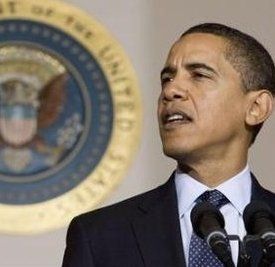
President Obama managed to get a decent economic stimulus bill through Congress, despite nearly wall-to-wall Republican opposition. However, this victory was easy compared to the challenges that await the president and the country. There are three big ones: passing a second round of economic stimulus spending by late spring; stopping the epidemic of home foreclosures; and getting the banking system functioning again.
If Obama were being graded on these three challenges, he'd get an B-plus on the first stimulus package, and an incomplete on the other two.
The recovery bill was about half the level needed, given how rapidly the economy is collapsing. One example: state and local governments will be out at least $400 billion this year and next due to falling revenues. But the stimulus bill replaces only about $140 billion of that. The result is needless layoffs, cutbacks in programs, and deferred public investments. In a severe recession, these cuts are nothing short of insane. You hear critics say that it takes a long time for infrastructure spending to be shovel-ready. But when it comes to prevention of needless cuts in existing outlays, all Washington needs to do is write a check.
Unemployment is increasing at an accelerating rate. It is very likely to be in double digits by summer. A second stimulus package, at least as large as the first, will be needed later this spring. And the politics will be even uglier. Republicans will point to the worsening economy and declare, "See, it didn't work."
Even more difficult will be the politics and economics of fixing the banking system. A surprisingly broad consensus of experts agrees that sooner or later, government will need to take the large banks into receivership. And better to do it sooner. The money-center banks are insolvent, to the tune of somewhere between one and two trillion dollars. Treasury Secretary Tim Geithner's strategy is to disguise this reality, in the hope that "private capital" - meaning hedge funds and private equity companies - can be enticed into buying toxic securities, and getting them off the books of banks. Geithner even proposes to have the Federal Reserve lend them the money.
But Geithner has not solved the problem of how to price these toxic assets. And unless he proposes to further subsidize speculative investments by hedge funds, the problem is insoluble. The longer government delays recognizing the insolvency of the banks and the need for a full government takeover, the longer the credit system stays frozen and the deeper the toll on the real economy.
Geithner is still operating according to the playbook of former Treasury Secretary Henry Paulson, who lurched from one failure to another. Geither made the transition from junior member of Paulson's team to senior adviser to Obama. But he has not revised his understanding of the problem. The time when the old banking system could just be propped up with more public money or cheap interest rates is long past.
The reality is that before this is over, government will have to spend at least another trillion dollars in emergency stimulus spending, and another trillion or two on top of that to rebuild the nation's banking system. To take the worst case, three trillion dollars is about twenty percent of one year's GDP. By coincidence, that's almost exactly what the Japanese government spent when, after dithering for nearly a decade of financial crisis in the 1990s, they finally forced banks to write down bad loans and put government firmly in charge in exchange for government capital.
Twenty percent of GDP in additional spending would push the U.S. public debt to around 70 percent of GDP, still far below its postwar peak in 1945. This is entirely possible and necessary economically. The challenge is selling it politically.
The conventional wisdom is that the deficit is alarmingly high, and there is a populist backlash against more help for the banks. Geithner is deliberately vague about his bank rescue plan. He deliberately relies on funding from the Federal Reserve because Congress is no mood to legislate another nickel for big banks.
Nor should it. The country will need this level of spending--but it should not go to the bankers who got us into this mess. They deserve pink slips, like so many millions of their innocent victims. The only way that President Obama will be able to sell larger scale spending is by making a lot more trips like his visits to Elkhart and Peoria, and telling a narrative of the undeserved suffering of ordinary American families and then connecting that story to a recovery plan big enough to do the job.
The additional money for a second stimulus package needs to go to preserve and create jobs. The added funds for "the banks" must go not to the present managers of the banks, but to the rebuilding of a banking system that serves the real economy. And the best place to begin to demonstrate that the administration is on the side of ordinary people rather than Wall Street is through a mortgage refinancing program where the aid goes directly to homeowners, not via banks or bondholders.
In short, the only way Congress will entertain spending another two or three trillion dollars in emergency funds is if President Obama makes crystal clear both the urgent need and the fact that they money is going to help regular people, not bankers. If he does that, he will make it impossible for Republicans to outflank him with a faux-populism.
It is fine to keep holding out an olive branch of bipartisanship - as long as Obama keeps governing with Democratic votes while Republicans stonewall. If he does his job, not only will public outlay on this scale become acceptable to broad public opinion; it will become harder and harder for Republicans to oppose.
Obama's political advisers seem to grasp this reality. But his top economic advisers are still tied far too closely to Wall Street. The brutal fact is that Wall Street as we know it is dead, and deserves to be dead. By the time this crisis is over, the banking system should be far more modest, both in its scale and in its pretensions. At the peak of the financial bubble, the banking system accounted for forty percent of all corporate profits. This does not add value to the real economy; it simply adds cost and risk. Rather than propping up failed banks, Obama's team should be looking forward to a drastically simplified banking system. Putting Wall Street in its place would be good economics and better politics.
Right now, spending another two-to-three trillion dollars seems unthinkable. But it will soon be urgently necessary. Obama will be able to persuade Congress to spend this scale of public money only if he spends it on the right things and gets the people on his side first.
Robert Kuttner is co-editor of The American Prospect. He is author of "Obama's Challenge: America's Economic Crisis and the Power of a Transformative Presidency."
